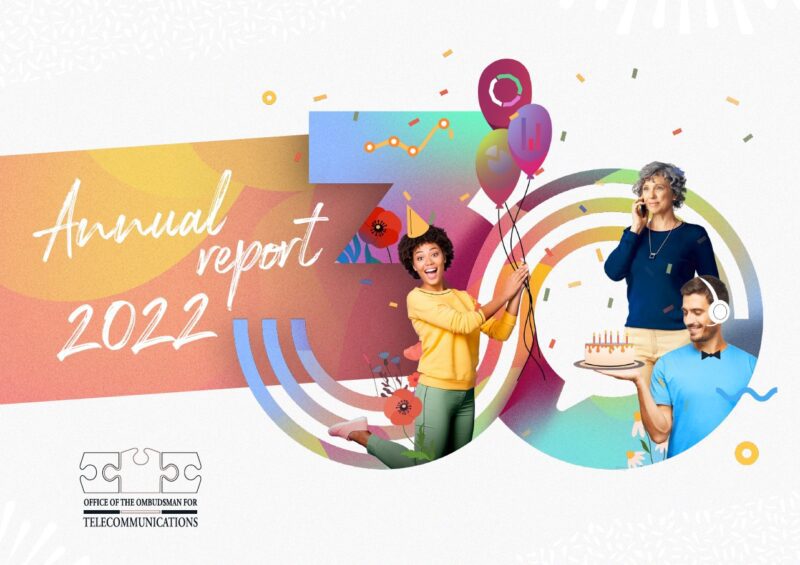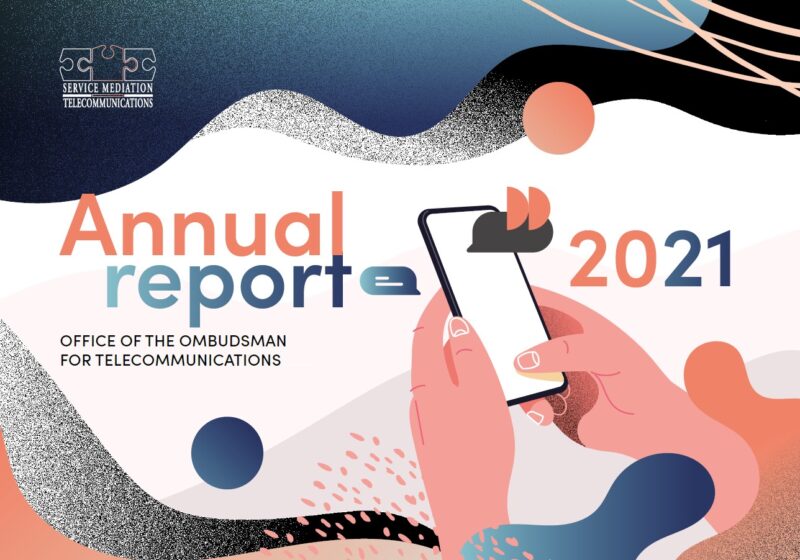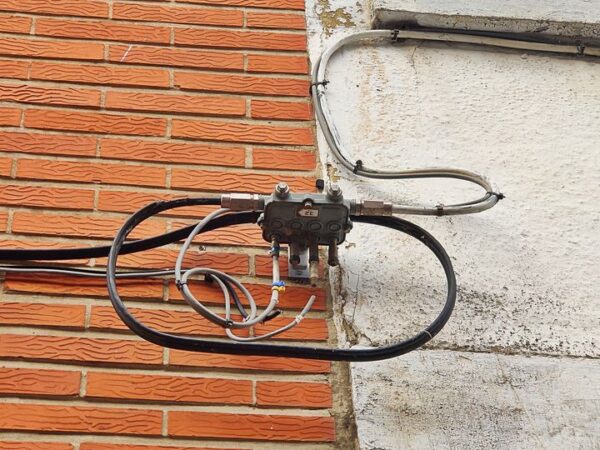Annual Reports of the Telecommunications Ombudsman Service
2023 annual report
On the occasion of the publication of the 2023 annual report the Telecommunications Ombudsman points out an exceptional increase of about 65% of the complaints compared to 2022. After several years of diminishing complaints, last year they totalled to 17,413, the highest number since 2015. This increase involves all the operators and was mostly marked in the case of the Telenet Group following problems with its new IT platform. Apart from that increase, the Mediation Service identifies several issues that impacted users in 2023 and formulates a number of recommendations in its annual report.

65% increase of complaints compared to 2022
In 2023 the Mediation Service for telecommunication registered 17,413 written requests for intervention and answered close to 7,000 requests for information by way of its telephone service. The number of complaints increased by 65% compared to 2022 (10,574 complaints). This increase is observed both for mediation complaints (from 8,605 in 2022 up to 15,168) and for investigations about malicious use of electronic communications networks, such as telephone harassment (from 1,969 in 2022 to 2,245). This year the ranking of the first five operators in terms of complaints is unprecedented: for the first time in the existence of the Mediation Service, Telenet Group takes first position followed by Proximus Group, Orange Belgium, VOO and Unleashed (better known by the brand names Mobile Vikings and Jim Mobile). For each of those five operators the number of registered complaints increased by at least 20%. Telenet Group takes the lead with an exceptional increase of complaints in 2023 (+188.62%). In second position Proximus Group, which includes operators Proximus and Scarlet, shows a 30.07% increase of its number of complaints compared to 2022. Finally, Orange Belgium (+23.96%), VOO (+20.27%) and Unleashed (+31.40%) end 2023 with notable increases of the number of complaints addressed to the Office of the Ombudsman.
Telenet: annus horribilis
Telenet Group generated 6,620 complaints in 2023, which is more than triple the amount of 2022, when 1,980 mediation complaints were lodged against Telenet. This increasing inflow started as early as November 2022, continued throughout 2023 and remains high even at the start of 2024. Not only the significant increase in number, but also the nature, seriousness, structural, persistent and, in some cases, unique nature of the problems, justify the attention the Mediation Service devotes to Telenet in this annual report.
The complaints covered a large spectrum of the contractual relation between users and the operator, involving issues ranging from the activation of services, billing, customer service and unexecuted termination requests. Conciliations in thousands of complaints show that the launch of a new IT platform by Telenet has generally been the cause of the countless persistent problems that have often strongly impacted its customers. More specifically regarding the front-line services, customers were faced with long waiting times or found they had not been properly helped, so they often turned to the Mediation Service as a last resort.
Two categories of complaints on the rise: malfunctions/breakdowns and customer service
In 2023 the Office of the Ombudsman was confronted with a significant rise in complaints regarding the customer service and several breakdowns and malfunctions. A bit more than 2,500 complaints were introduced in 2023 for problems regarding the customer service (1,182 in 2022). Those complaints are about the accessibility of the operators (long waiting times) and the lack of means of communication to reach them, among other things. The rest of the complaints concern the quality and efficiency of the customer services, with complainants raising issues with customer-orientation, no internal follow-up and referral to digital solutions or online platforms.
Considering the number of complaints the Office calls on the operators to ensure that the customer service is operational, solution-oriented and easily accessible. The persistent complaints about long waiting times and (telephone) accessibility are worrying. The breakdowns, malfunctions and unavailability of services resulted in nearly 4,000 complaints in 2023, which means an increase of more than double the number registered in 2022 (1,685 complaints). Examples of issues raised are unavailable services following a breakdown, fibre roll-out, infrastructure works or bad weather.
In such cases the Office urges the operators to show diligence, proactivity and anticipation. It is indeed the operator’s duty to make every effort to restore the services or to offer alternative solutions without extra costs for subscribers as soon as possible. Finally automatic repayment of the subscription fee corresponding with the time of unavailable service should be made to subscribers. Because of the inconvenience suffered, operators should also consider compensating.
Contract termination: still not a streamlined process in 2023
Despite the legal adjustments made in 2012 and 2021 regarding contract termination and limiting the termination fees, terminating an electronic communications service contract is still complicated. The Office of the Ombudsman registered a bit more than 1,000 complaints in 2023, i.e. close to double the number of complaints in 2022 about this issue. Examples are the difficulties to introduce and receive the termination, the issues during the Easy Switch procedure, the termination of bundled offers or the complexity of terminating “business” contracts in which a telephone central is involved. Taking into consideration the competitiveness of the electronic communications sector, the possibility of unilateral termination constitutes a key issue. In a constantly evolving market it is important for end-users to be able to opt out of a particular service or even potentially change operators, if they need to. However, based on the complaints treated, the conclusion must be that subscribers are not well informed, despite the various legal obligations for operators to provide information. Apart from that, as regards professional subscribers in particular, certain commercial practices (penal clauses, renting of terminal equipment) appear to be real obstacles to terminate a contract. Therefore the Office of the Ombudsman recommends operators to show more diligence when handling requests to terminate a contract, to confirm every such request and to proactively reimburse any payments wrongfully received after the termination.
Annual report 2022
On the occasion of the publication of its 2022 annual report the Mediation Service looks back to its 30 years of existence and its equally long experience in handling complaints in the telecommunications sector. Since 1993 we have handled a total of a little over 420,000 complaints in the context of our missions. Since 2018 we are witnessing a downward trend for the evolution of the number of complaints. Nevertheless, the Mediation Service notices an increase within certain categories of complaints and issues a number of recommendations in its annual report.

More than 10,000 written complaints
In 2022, the Mediation Service for Telecommunications received 10,574 written complaints and in addition answered approximately 6,000 requests for information in the context of its telephone helpdesk. This represents a decrease in the number of complaints compared to 2021 (13,355 complaints). This decrease regards both the mediation complaints (from 10,648 in 2021 to 8,605) and the complaints regarding the malicious use of communications networks such as harassment by telephone (from 2,706 in 2021 to 1,969). In 96.91% of the mediation complaints it was possible to reach an acceptable solution for the telecommunication user through an amicable settlement. In the context of the requests for identification of suspected perpetrators of malicious calls and messages, it was possible to identify the perpetrator in nearly half of the cases.
Vulnerable users: specific customer service and electronic invoicing
In 2022, 367 requests for mediation were registered (+32% compared to 2021), submitted by consumers who had been identified as vulnerable users. The complaints in particular regard fraud through premium-rate numbers (090X, …), phishing, digital invoicing (e-invoicing) and interference of fixed lines.
The Mediation Service wishes to emphasize once more the need for operators to ensure an easily accessible and efficient telephone helpdesk. In this context the Office of the Ombudsman pleads for the implementation of a dedicated policy for vulnerable users by the operators. After the example of an initiative in the United Kingdom, operators could be requested to appoint a specific person as point of contact for requests of vulnerable telecom users.
Finally, the Office of the Ombudsman finds that the e-invoicing trend is winning ground rapidly. Some categories of subscribers need a guiding hand in this digital transition and more specifically our elders who are sometimes not or insufficiently familiar with the new information technologies. In any case, operators have to respect the freedom of choice of the consumer, regarding the format of the invoices (electronic or paper).
Fibre roll-out: complaints are multiplying
In 2022, 155 complaints were submitted to the Mediation Service, following the roll-out of fibre. The main issues found were the compulsory switch to fibre, without explanations or consent from the subscriber, a price increase following the switch to fibre and the issues relating to the installation and activation of this new technology (facade right).
A number of users on the contrary, complain about the waiting times for a fibre connection. The latter wish to enjoy a faster and more stable Internet connection. That does not only apply to private persons but also to companies situated in rural or remote areas.
In light of the intensification of the fibre roll-out on Belgian territory, the Office of the Ombudsman invites the players in the field to safeguard the rights and interests of the end-users. On the one hand by honouring the obligations regarding transparency and communication upon installations and activations of new subscription formulas and on the other hand by reconciling the facade right of the telecommunications company with the building owners’ right of use.
Keeping in check the final invoice: a necessity in the current context
In light of the current situation (increasing energy costs, inflation, etc.) it is becoming ever more important for telecommunications customers to avoid additional fees and to keep their invoices in check. In 2022, 4,570 telecom users lodged a complaint about an irregularity regarding their monthly subscription, such as unexpected consumption charges, additional one-time fees, discounts that have not been granted and administrative issues to be dealt with. The complainants’ testimonies show that the complainants were not informed or informed too late and/or did not have sufficient means to avoid additional costs.
A clear trend to shift the responsibility towards the user is standing out as well. The latter is considered to be sufficiently informed through an operator’s application or website, while the Mediation Service notices in the complaints that this information is not always reliable. This is the operators’ way of making their customers accountable, whereas the latter do not always know how to manage such tools, for instance elders and vulnerable users in particular.
The Office of the Ombudsman also pleads for an improved information of the user, for instance via real-time notifications for mobile (roaming) consumption and by blocking third-party services (M-commerce) by including a mandatory opt-in for those services in the telecommunication contracts.
ANNUAL REPORT 2021
DIGITAL EVOLUTION REMAINS A CHALLENGE FOR MANY.
The ongoing pandemic measures in 2021, such as structural working from home and distance learning, once again demonstrated the need for well-functioning telecom services.
However, on the basis of the complaints received in 2021, the Telecommunications Ombudsman found that both switching operators (via Easy Switch) and the right to social tariff and e-invoicing in particular caused difficulties for vulnerable users.

Easy Switch procedure still not applied by default
The Easy Switch mandate was created to facilitate the transition between operators for telecom users. Despite this, the Ombudsman service notes an increase in the number of complaints and this procedure is still not sufficiently regarded as the standard procedure for changing operators. Subscribers are still too often confronted with double invoicing and are too often sent from box to wall by the operators involved.
Structural user problems around social tariff
Several structural problems came to light in the complaints regarding the social tariff. The Ombudsman continues to believe that many complaints could be avoided if the social rate were automatically granted to all beneficiaries. This would not only ease administrative formalities for users and operators, but would also lead to greater fairness. It would also ensure that the social tariff is not unfairly withdrawn when beneficiaries change their subscription, switch to another operator or move.
E-invoicing: a growing phenomenon
Electronic invoicing is becoming increasingly common in the telecommunications sector and is on the rise. However, e-invoicing is still proving to be a real challenge for a large part of the population, especially for some elderly people. A transition to digital invoicing therefore requires a gradual approach and guidance of the operators for certain, vulnerable users.
Unlimited offers
Attractive advertisements about ‘unlimited’ surfing, calling or texting must be clarified to the end user before the start of a subscription if restrictions or a Fair Use Policy would nevertheless apply to the proposed offer. After all, a reduction in internet speed or even a sudden blockage of services must be avoided in times of structural homeworking.
2021 in figures
In 2021, the Telecommunications Ombudsman Service registered 13,355 written requests for intervention. The number of complaints shows a decreasing trend (-4.87%) compared to 2020 (then 14,039 complaints). This decrease was noticeable both in mediation complaints (from 11,142 in 2020 to 10,648) and in complaints relating to telephone harassment (from 2897 in 2020 to 2706).
In 2021, 14,049 cases were analysed, handled and closed, which is an increase compared to 2020 (with 13,676 complaints handled). In 96.96% of the complaints, the telecom user agreed to an amicable settlement.




